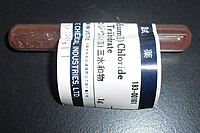Rhodium(III) chloride
| Rhodium(III) chloride | |
|---|---|

| |
| General | |
| Other names | Rhodium trichloride |
| Molecular formula | RhCl3 |
| Molar mass | 209.26 g/mol (anhydrous) |
| Appearance | dark red solid |
| CAS number | [10049-07-7] (anhydrous) |
| EINECS number | 233-165-4 |
| Properties | |
| Density and phase | 5.38 g/cm3, solid |
| Solubility in water | soluble |
| Melting point | 450 °C (uncertain) |
| Boiling point | 717 °C |
| Acidity (pKa) | acidic in solution |
| Standard enthalpy of formation ΔfH°solid |
-234 kJ/mol |
| Structure | |
| Coordination geometry |
octahedral |
| Crystal structure | YCl3 |
| Safety data | |
| EU classification | not listed |
| PEL-TWA (OSHA) | 0.001 mg/m3 (as Rh) |
| IDLH (NIOSH) | 2 mg/m3 (as Rh) |
| Flash point | non-flammable |
| RTECS number | VI9290000 |
| Related compounds | |
| Other anions | Rhodium(III) fluoride Rhodium(III) bromide Rhodium(III) iodide |
| Other cations | Cobalt(II) chloride Iridium(III) chloride |
| Related compounds | Ruthenium(III) chloride Palladium(II) chloride |
| Except where noted otherwise, data are given for materials in their standard state (at 25 °C, 100 kPa) Infobox disclaimer and references | |
Rhodium(III) chloride is the end-point of the separation of rhodium from the other platinum group metals, and hence the starting material for most rhodium chemistry. It is a dark red crystalline solid, notably hygroscopic particularly when anhydrous. It is usually encountered as a non-stoïchiometric crystalline hydrate (CAS number [20765-98-4]) which contains approximately three water molecules for each rhodium atom.
Chemical properties
RhCl3 is unstable at high temperatures, decomposing to the elements. It can act as a Lewis acid, and form chloride complexes such as octahedral, diamagnetic (low spin) K3[RhCl6]. When this is treated with water, the complex K2[Rh(H2O)Cl5] is formed. If the caesium complex Cs3[RhCl6] is suspended in cold 1 M HNO3 and treated with Template:Cerium4+ and chlorine, a green rhodium(IV) complex Cs2[RhCl6] is formed. This is a strong oxidiser, much less stable than the corresponding iridium(IV) complex.
Hydrated RhCl3 can be used to prepare a variety of Rh(III) complexes. For example an ethanolic solution reacts with dialkyl sulfides:
RhCl3 + 3 SR2 → [RhCl3(SR2)3]
Complexes with phosphines such as [RhCl3(PR3)3] are prepared similarly. All of these complexes are kinetically inert octahedral complexes, able to form fac or mer stereoisomers.
Rhodium(III) is a stable oxidation state which often resists oxidation or reduction. If an aqueous ethanolic solution of pyridine (py) and RhCl3 is oxidised by air, a blue paramagnetic Rh(III) complex [Cl(py)4Rh-O2Rh(py)4Cl]5+ is formed. Meanwhile zinc reduction of RhCl3 in aqueous ammonia containing ammonium sulfate gives a colourless air-stable Rh(III) complex [RhH(NH3)5SO4].
Preparation
Rhodium(III) chloride is usually prepared by reaction of chlorine with rhodium sponge at 200-300°C in the presence of sodium chloride, followed by recrystallization from concentrated hydrochloric acid. This method avoids the presence of nitrogen-containing impurities in the product. The hydrate can be produced by the action of hydrochloric acid on hydrated rhodium(III) oxide.
Uses
Rhodium(III) chloride is often the starting point in the synthesis of rhodium-based catalysts, which are popular for reactions such as hydrogenation of alkenes. The most important of these is Wilkinson's catalyst, prepared using triphenylphosphine in ethanol solution:[1]
- RhCl3(H2O)x + PPh3 → RhCl(PPh3)3 + Ph3P=O (Not balanced)
It is also used for the preparation of other rhodium(I) complexes. Stirring a methanol solution of RhCl3 under 1 bar of carbon monoxide for 3–4 hours produces a solution of the dicarbonyldichlororhodate(I) anion, [RhCl2(CO)2]−. The rhodium analogue of Vaska's complex, trans-carbonylchlorobis(triphenylphosphine)rhodium(I), is prepared by refluxing RhCl3 with excess triphenylphosphine and formaldehyde in ethanol.[2] The alkene complexes di(μ-chloro)bis(η4-1,5-cyclooctadiene)dirhodium(I)[3] and di(μ-chloro)tetrakis(η2-cyclooctene)dirhodium(I)[4] can also be easily prepared.
A useful catalyst for "directed hydrogenation", where a nearby hydroxy group coordinates to rhodium and directs the reaction, is prepared from RhCl3·3H2O, a phosphine and norbornadiene.[5]
RhCl3 itself can act as a catalyst. For example it can dimerise ethene to a mixture of cis and trans 2-butene isomers:[6]
- 2 C2H4 → CH3-CH=CH-CH3
Unfortunately this reaction fails for higher alkenes.
When 1,3-cyclooctadiene is treated with RhCl3 in ethanol, followed by potassium cyanide, it forms the isomer 1,5-cyclooctadiene.
Safety
Rhodium(III) chloride is not listed under Annex I of Directive 67/548/EEC, but is usually classified as harmful, R22: Harmful if swallowed.
It is listed in the inventory of the Toxic Substances Control Act (TSCA).
Suppliers
Bibilography
- . ISBN 0-7506-3365-4.
{{cite book}}: Missing or empty|title=(help); Unknown parameter|Author=ignored (|author=suggested) (help); Unknown parameter|Publisher=ignored (|publisher=suggested) (help); Unknown parameter|Title=ignored (|title=suggested) (help); Unknown parameter|Year=ignored (|year=suggested) (help) -
{{cite book}}: Empty citation (help)
References
- ^ Bennet, M. A.; & Longstaff, P. A. (1965). Complexes of Rhodium(I) with Triphenylphosphine. Chem. Ind. (London) 846. . ISBN 0935702512.
{{cite book}}: Missing or empty|title=(help); Unknown parameter|Author=ignored (|author=suggested) (help); Unknown parameter|Publisher=ignored (|publisher=suggested) (help); Unknown parameter|Title=ignored (|title=suggested) (help); Unknown parameter|Year=ignored (|year=suggested) (help) - ^ Evans, D; Osborn, J. A.; & Wilkinson, G. (1968). trans-Chlorocarbonylbis(triphenylphosphine)rhodium and Related Complexes. Inorg. Synth. 11:99–101.
- ^ Giordano, G.; & Crabtree, R. H. (1979). Di(μ-chloro)bis(η4-1,5-cyclooctadiene)dirhodium(I). Inorg. Synth. 19:218–20.
- ^ van der Ent, A.; & Onderdelinden, A. L. (1973). Chlorobis(cyclooctene)rhodium(I) and -iridium(I) Complexes. Inorg. Synth. 14:92–95.
- ^ J. M. Brown, J. M.; Evans, P. L.; &James, A. P. (1993). Org. Synth. Coll. Vol. 8:420.
- ^ . ISBN 0412108704.
{{cite book}}: Missing or empty|title=(help); Unknown parameter|Author=ignored (|author=suggested) (help); Unknown parameter|Publisher=ignored (|publisher=suggested) (help); Unknown parameter|Title=ignored (|title=suggested) (help); Unknown parameter|Year=ignored (|year=suggested) (help)